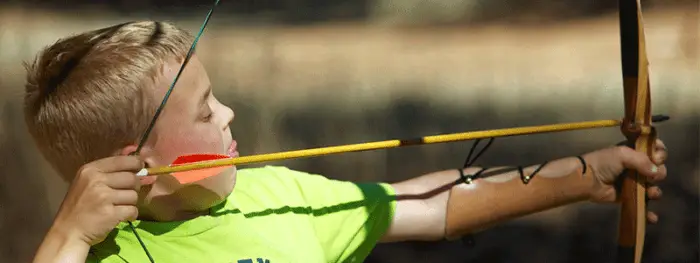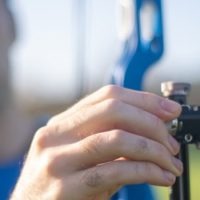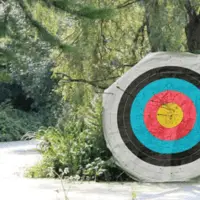A bow’s draw weight is the amount of force required to pull the string to the proper position for shooting. Measuring it and adjusting it to your needs is incredibly important for your accuracy and general shooting form.
To measure a bow’s draw weight, you’ll need a weight scale. You take the measurement by attaching the scale to the bowstring near the nock, pulling the string to full draw, and reading the scale. To eliminate human error, take the measurement multiple times.
A bow adjusted to a high draw weight will not enable you to perform the shot properly, while a low one will not allow you to unlock your full potential.
Different types of bows require you to pull the string to a different position, depending on its draw length. For a traditional bow, you should pull the string for about 28 inches from the natural starting point. For a compound bow, you need to draw the bow to the wall (which is the point where the bow will not allow you to pull any further).
Most traditional and recurve bow’s draw weight cap at around 55 pounds, whereas compound bows can go up to 70 pounds and higher. Some bows have an adjustable draw weight, but others have only one draw weight setting.
Note: Some of the links on this page are affiliate links. This means that if you buy through one of them, I’ll earn a small commission, at no additional cost to you. It’s a great way to support the website.
Measuring the draw weight on a bow
To measure the draw weight on any bow, you’ll need to use a draw weight scale to pull the bow back and take the reading. Most draw weight scales have some hook or attachment you can connect to the bowstring, and use it as a release aid to pull the bow back.
The steps of measuring the draw weight on a bow:
- Ready your equipment: the bow and a draw weight scale.
- Attach the draw weight scale to the bowstring, near the nock.
- Raise the bow and pull it back to full draw, keeping good form.
- Read the measurement on the draw weight scale.
You may take these steps multiple times to get a more accurate measurement.
Make sure that you’re using good form pulling the bow back, or the reading might not be accurate. If you’re having a hard taking the measurement, the draw weight on the bow is definitely too high.
When choosing a draw weight scale, you shouldn’t go overboard, since a simple one will do the trick. I suggest getting Luoyer Archery Bow Scale, which is really affordable on Amazon. It’s a digital scale that can measure up to 110 pounds, and is pretty easy and comfortable to handle. I think it’s a good pick.
How do I find my ideal bow draw weight?
Finding your ideal draw weight is really important. As we discussed before, knowing it and adjusting your bow to it will allow you to perform your shots with maximal energy without sacrificing your proper shooting form.
To find your ideal bow draw weight, use a weight scale to pull the bowstring to the correct position. If it feels hard to pull back and hold, lower the weight by a few pounds. Aim to use the highest weight that feels comfortable to you.
Some archery activities require a minimal draw length to do. For example, bowhunters typically don’t use a bow with a draw weight lower than 40 pounds. Using a draw weight you’re comfortable with, but challenged by, will ensure that you’ll get stronger and improve over time.
But to do this process, you will need to incrementally adjust the weight on your bow. So we should also discuss how to do just that.
How to adjust the poundage on your bow
Whether you want to test and check your exact pull strength, or if you want to adjust your bow to better suit your needs, you might want to know how you can adjust your bow’s draw weight.
To adjust the draw weight on a compound bow, all you have to do is change the load on the limb using the limb bolt. Most archery stores offer this service within a bow tune, but you can do it yourself.
To adjust your compound bow to higher draw weight, you should first locate the limb bolt on your bow. It should be located in the center of your bow. If you want a higher draw weight on your bow, tighten the limb’s locking screw, and if you want to lower it, loosen the screw. This would change the amount of stress on the bow’s string to suit your needs.
Make sure to adjust bow bolt equally, because different limb stress affects the position of your cams, and can hurt your accuracy.
You can want a quick video about adjusting your draw weight I’ve found helpful
Most compound bows have a range of around 10 pounds for adjustments, so it’s wise to make an informed purchase when you first buy your bow. Make sure to only adjust the weight within the poundage range provided by the bow – putting too much or too little stress on the bow might damage it, and can actually be dangerous for the user.
If you feel uncomfortable doing this tune yourself or simply want an expert’s opinion, you can go to your local archery shop for a bow tune. Most shops will include this adjustment within the tune, with a very affordable price.
It’s a good idea to have a professional look at your bow every now and then anyway, and make sure it functions properly. Just ask them to measure your draw weight and set it correctly.
Most recurve bows come with specific draw weight and do not allow tuning and tweaking. If you have a takedown recurve bow, you’ll be able to change the draw weight, but it’ll require replacing the limbs of the bow. It’s a good idea to choose a proper draw weight that suits your strength when purchasing a recurve bow.
What is a good draw weight for me?
After making the necessary measurements and adjusting your bow, you probably want to know how you do compare to the average person. Remember that a trained archer will usually be stronger than the average person and that proper form has a lot to do with how energy efficient you are, so training your skills has everything to do with it.
| Body type | Compound bow suggested draw weight [lbs] [1] | Recurve bow suggested draw weight [lbs] [2] |
| A small child (40 to 70 lbs.) | 10# – 15# | 10# – 15# |
| Child (70 to 100 lbs.) | 15# – 20# | 15# – 20# |
| Women and large-framed boys (100 to 140 lbs.) | 30# – 40# | 25# – 35# |
| Women with a larger frame & youth boys (140 to 160 lbs.) | 40# – 50# | 30# – 45# |
| The majority of males (160 to 190 lbs.) | 55# – 65# | 30# – 55# |
| Larger males (190+ lbs.) | 60# – 70# | 45# – 60# |
This chart can also be useful if you are a beginner and can’t make the proper measurements yet, for example when picking your first bow, or as a starting point for a first-time adjustment.
A more general poll done at the archerytalk forum suggests that most bowhunters shoot with draw weights of 55-64 lbs – almost 45% of people say their poundage is within this range. The full statistics:
| Draw weight [lbs] | Percentage of Archers |
| 75# > | 5.2% |
| 65# – 74# | 37.1% |
| 55# – 64# | 44.9% |
| 45# – 54# | 12.2% |
| 44# < | 0.6% |
This should show you what range you should aim to, based on where on the bell curve you think you should be.
Can you increase your draw weight on a bow?
Now that you know how important your draw weight is, and how to effectively measure it using your bow, you probably wonder how you can increase it.
This is not the most important aspect of archery, since your actual technique may be more important than how much you can pull, but effectively increasing your poundage may allow you to perform better.
You can increase your maximum draw weight on a bow by working on your strength and on your archery technique. To do that you need to shoot often and perfect your form. You can also exercise to speed this process up.
The first thing you should do when trying to strengthen your archery muscles is to train frequently. This way you’ll work specifically on your weaker muscles, but also improve your overall technique.
When you train, try to pull your bow and hold the arrow pointed towards the target for as long as you can. This exercise will work on your strength and endurance. You can also choose to shoot closer to the target, so you can knock down as many arrows as you can in a short period of time.
Best exercises for increasing your draw poundage
Consider adding some alternative exercises that work on the specific archery muscles. You mainly want to train your back, shoulders, core, and rotator cuffs. These will enable you to exert more force in your shots, but also pull and hold your bowstring. Intuitively, you should mostly practice pulling exercises. The main exercises you should focus on are:
- Pull-ups – just put your hand on a bar and pull your body upwards. This exercise will strengthen your back and biceps.
- Rows – same kind of pulling motion, but this time from a forward position backward. You can use a dumbbell, barbell, or a machine. Rows mainly focus on your back.
- Bent over raises and lateral raises – using a small dumbbell or a machine. To perform a bent-over raise, bend your body forward, put your hands straight to the ground, and then raise them to a “T” position. To perform a lateral raise stand straight, extend your hands towards the ground, and raise them to a “T” position. These exercises work on different parts of your shoulders.
- Reverse flies – using a machine, put your hands forwards, in a way where the weight pulls your hands together. Then pull your hands to a “T” position. This will work directly on your rotator cuffs.
- Plank – simple bodyweight core exercise. Put your hands and elbows on the ground, and extend your body to be balanced on the tips of your feet. Don’t push your butt towards the sky, and don’t let your body collapse to the ground. Stay still for as long as you can.
If you have trouble at all with these exercises, there are a lot of websites discussing them and their proper technique, and also alternatives you can do. The best exercise to increase your draw weight, intuitively, is to practice shooting your bow.
Conclusions
Measuring your bow’s draw weight and adjusting it according to your current capabilities is a really important aspect of tuning your bow. It’s really simple to do, but remember that it’s more important to suit your bow to your needs than knowing your exact pull strength and comparing yourself to the average. You should also aim to initially pick a bow with a draw weight that will be comfortable for you.
With time and practice, you can and will increase your pull strength, but strengthening your muscles and improving your technique. You can also use some simple exercises to help speed this process.
If you want to learn about more measurements you should make to tune your bow so it perfectly fits your needs, I have just the posts for you. Try reading my post that details what is brace height on a bow, and my post about finding your ideal draw length.
In any case, I really hope this article was helpful for you and that you applied the information here to adjust and work on your draw weight.
FAQ
What is draw weight on a bow?
Draw weight is the total amount of weight that is needed to be pulled to fully draw the bow. This weight is then applied on the arrow when it’s being shot. Draw weight is typically measured in pounds.
How do I know what’s the draw weight of my bow?
To measure the draw weight on your bow, all you need is a draw weight scale. This instrument can be used to accurately measure the poundage of the bow, and all you need to do it use it to draw the bow and read the measurement.
What is a good draw weight for beginners?
Beginners should typically avoid looking at the numbers, and simply focus on creating muscle memory, shooting a bow you’re comfortable with. A 20# bow should be good to start with, for an adult.





How can I tell the minimum or maximum draw weight of my High Country Supreme? The sticker on bow is worn off.
Good question. It can be a bit tricky to find sometimes, but most archery brands do hold their past catalogs on their websites.
With HCA they definitely have them: you can actually find them on this page. Find the draw weight section under the bow specs.